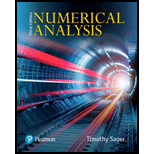
Numerical Analysis
3rd Edition
ISBN: 9780134696454
Author: Sauer, Tim
Publisher: Pearson,
expand_more
expand_more
format_list_bulleted
Question
Chapter 9.3, Problem 4CP
a.
To determine
To find: The probability of the random walk reaching the top a of the given interval
b.
To determine
To find: The probability of the random walk reaching the top a of the given interval
c.
To determine
To find: The probability of the random walk reaching the top a of the given interval
Expert Solution & Answer
Want to see the full answer?
Check out a sample textbook solution
Students have asked these similar questions
practice problem please help!
Please ensure that all parts of the question are answered thoroughly and clearly. Include a diagram to help explain answers. Make sure the explanation is easy to follow. Would appreciate work done written on paper. Thank you.
Find a parameterization for a circle of radius 4 with center (-4,-6,-3) in a plane parallel to the yz plane.
Write your parameterization so the y component includes a positive cosine.
Chapter 9 Solutions
Numerical Analysis
Ch. 9.1 - Find the period of the linear congruential...Ch. 9.1 - Find the period of the LCG defined by a=4,b=0,m=9...Ch. 9.1 - Approximate the area under the curve y=x2 for 0x1,...Ch. 9.1 - Approximate the area under the curve y=1x for 0x1,...Ch. 9.1 - Prob. 5ECh. 9.1 - Prove that u1=x21+x22 in the Box-Muller Rejection...Ch. 9.1 - Implement the Minimal Standard random number...Ch. 9.1 - Implement randu and find the Monte Carlo...Ch. 9.1 - (a) Using calculus, find the area bounded by the...Ch. 9.1 - Carry out the steps of Computer Problem 3 for the...
Ch. 9.1 - Use n=104 pseudo-random points to estimate the...Ch. 9.1 - Use n=104 pseudo-random points to estimate the...Ch. 9.1 - (a) Use calculus to evaluate the integral 01x2x,...Ch. 9.1 - Prob. 8CPCh. 9.1 - Prob. 9CPCh. 9.1 - Devise a Monte Carlo approximation problem that...Ch. 9.2 - Prob. 1CPCh. 9.2 - Prob. 2CPCh. 9.2 - Prob. 3CPCh. 9.2 - Prob. 4CPCh. 9.2 - Prob. 5CPCh. 9.2 - One of the best-known Monte Carlo problems is the...Ch. 9.2 - Prob. 7CPCh. 9.2 - Prob. 8CPCh. 9.2 - Prob. 9CPCh. 9.3 - Design a Monte Carlo simulation to estimate the...Ch. 9.3 - Calculate the mean escape time for the random...Ch. 9.3 - In a biased random walk, the probability of going...Ch. 9.3 - Prob. 4CPCh. 9.3 - Design a Monte Carlo simulation to estimate the...Ch. 9.3 - Calculate the mean escape time for Brownian motion...Ch. 9.3 - Prob. 7CPCh. 9.4 - Use Itos formula to show that the solutions of the...Ch. 9.4 - Use Itos formula to show that the solutions of the...Ch. 9.4 - Use Itos formula to show that the solutions of the...Ch. 9.4 - Prob. 4ECh. 9.4 - Prob. 5ECh. 9.4 - Prob. 6ECh. 9.4 - Use the Euler-Maruyama Method to find approximate...Ch. 9.4 - Use the Euler-Maruyama Method to find approximate...Ch. 9.4 - Apply the Euler-Maruyama Method with step size...Ch. 9.4 - Prob. 4CPCh. 9.4 - Prob. 5CPCh. 9.4 - Prob. 6CPCh. 9.4 - Use the Milstein Method to find approximate...Ch. 9.4 - Prob. 8CPCh. 9.4 - Prob. 9CPCh. 9.4 - Prob. 10CPCh. 9.4 - Prob. 11CPCh. 9.4 - Prob. 12CPCh. 9.4 - Prob. 1SACh. 9.4 - Prob. 2SACh. 9.4 - Prob. 3SACh. 9.4 - Prob. 4SACh. 9.4 - Compare your approximation in step 4 with the...Ch. 9.4 - Prob. 6SA
Knowledge Booster
Learn more about
Need a deep-dive on the concept behind this application? Look no further. Learn more about this topic, subject and related others by exploring similar questions and additional content below.Similar questions
- Using the method of joints, determine the force in each member of the truss shown. Summarize the results on a force summation diagram, and indicate whether each member is in tension or compression. You may want to try the "quick" method hod.16 8m T or C CD CE AB EF BF гид B 6m i force in CE only (change top force to 8kn) 8 KN 8kNarrow_forwardNo chatgpt pls will upvotearrow_forwardPlease ensure that all parts of the question are answered thoroughly and clearly. Include a diagram to help explain answers. Make sure the explanation is easy to follow. Would appreciate work done written on paper. Thank you.arrow_forward
- Please ensure that all parts of the question are answered thoroughly and clearly. Include a diagram to help explain answers. Make sure the explanation is easy to follow. Would appreciate work done written on paper. Thank you.arrow_forwarddangers of college kids carrying concealed handgunsarrow_forwardYou are coming home hungry and look in your fridge. You find: 1 roll and 2 slices of bread, a jar ofpeanut butter, one single serve package each of mayo and mustard, a can of cheezewhiz, some slicedham, and some sliced turkey. How many different types of (edible) sandwiches can you make? Writedown any assumptions (order matters or not, repetitons allowed or not).arrow_forward
- Answer the questionsarrow_forward~ exp(10). A 3. Claim number per policy is modelled by Poisson(A) with A sample x of N = 100 policies presents an average = 4 claims per policy. (i) Compute an a priory estimate of numbers of claims per policy. [2 Marks] (ii) Determine the posterior distribution of A. Give your argument. [5 Marks] (iii) Compute an a posteriori estimate of numbers of claims per policy. [3 Marks]arrow_forwardHow can I prepare for me Unit 3 test in algebra 1? I am in 9th grade.arrow_forward
arrow_back_ios
SEE MORE QUESTIONS
arrow_forward_ios
Recommended textbooks for you
 Linear Algebra: A Modern IntroductionAlgebraISBN:9781285463247Author:David PoolePublisher:Cengage Learning
Linear Algebra: A Modern IntroductionAlgebraISBN:9781285463247Author:David PoolePublisher:Cengage Learning

Linear Algebra: A Modern Introduction
Algebra
ISBN:9781285463247
Author:David Poole
Publisher:Cengage Learning
Intro to the Laplace Transform & Three Examples; Author: Dr. Trefor Bazett;https://www.youtube.com/watch?v=KqokoYr_h1A;License: Standard YouTube License, CC-BY